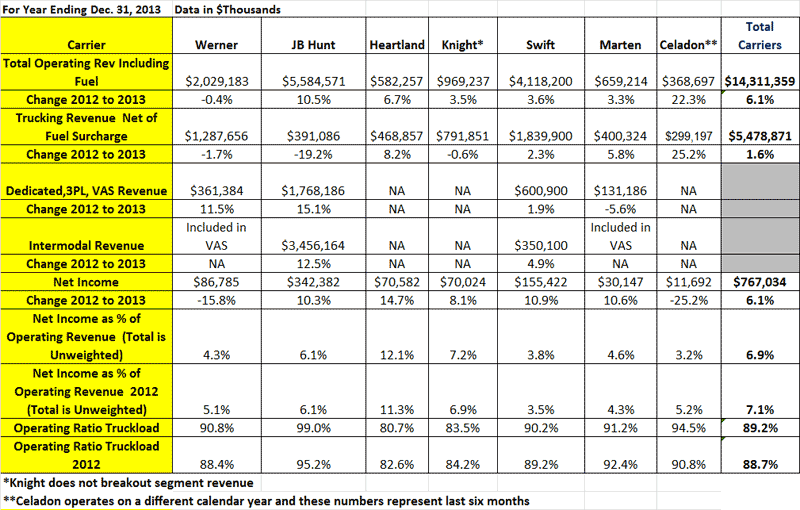Results were better for the full year 2013, as shown in the table below. Profits were up more than 6% versus 2012, and the full year operating ratios for truckload were just a bit above previous year levels.
US Truckload Results for Full Year 2013

See Full Size Image
As usual, we also share some of the more noteworthy management comments from the carriers from their Q4 earnings releases.
Werner
Noted that "Freight trends thus far in 2014 have been better than the same period in 2013."
Average revenues per total mile, net of fuel surcharge, rose 3.1% in fourth quarter 2013 compared to fourth quarter 2012 due partially to higher seasonal capacity surcharges in the One-Way Truckload fleet.
Noted that "The driver recruiting and retention market became even more challenging during fourth quarter 2013. Significant factors included a declining number of, and increased competition for, driver training school graduates, a gradually declining national unemployment rate, and increased job competition from the strengthening housing construction and hydraulic fracturing markets."
Werner ended the year with 7,162 trucks, down from 7,225 in 2012.
JB Hunt
The transformation away from straight truckload carriage continues. For the full year, its truckload business
contributed just 7% of total company revenue, versus, 10% in 212, and just 1% of profits versus 4% previously.
The trucking segment lost money in Q4 on a decrease in the number of trucks it operated. The tractor count was 1,857 compared to 2,093 in the fourth quarter 2012, primarily from a reduction in independent contractor capacity.
But business was good in other segments. Load growth of 13% in intermodal helped drive an 11% increase in segment revenue. Dedicated cntract services segment revenue increased by 17%, primarily from the addition of new customer accounts. Integrated capacity solutions segment revenue increased by 13%, mostly from a higher load count and an increase in revenue per load.
All told for the year, profits were up a healthy 10.3%.
Heartland Express
The big jump in Q4 revenue came mostly from the inclusing for the first time its previous acquisition of Gordon Trucking.
The company said "There has not been any significant change to GTI's legacy driver base as a result of the acquisition," and indeed, some have said companies such as Heartland are using acquisitions as the easiest way to add drivers.
Knight
Company said "Our revenue per tractor improved 3.2%, year over year, as a result of a 3.4% improvement in revenue per total mile with a 1.3% decrease in our length of haul. Miles per tractor were down 0.2%, as we were able to mitigate much of the impact from the new industry-wide regulations governing hours of service that went into effect in July 2013."
It too saw capacity shrink a bit in 2013, with a tractor count at the end of the year at 4,017 versus 4,096 at the end of 2012.
Marten
Company saw net income improve 10.6% to a record $30.1 million for the full year. However, profits were down in Q4, falling $7.3 million from $7.7 million in 2012.
The company said "These results were earned in a challenging rate environment with significant industry headwinds including higher equipment and maintenance costs, pay inflation to drivers within a contracting driver market and revised hours of service regulations."
Swift
Noted that "Despite a 1.4% reduction in our average operational truck count. we migrated approximately 250 trucks from our truckload segment to our dedicated segment to support the start up of several new customer accounts."
Truckload revenue net of fuel surcharges increased 2.3% during 2013, while average operational truck count decreased slightly to 10,833. The company achieve a 2.1% increase in revenue net of fuel surcharge per loaded mile.
Celadon
One of the few carriert to be actively adding capacity, the company said that it saw an increase in average seated tractor count of 720, or 26.7%, to 3,418 in the December 2013 quarter compared with 2,698 in the December 2012 quarter. Said this "was a significant operating metric improvement that resulted in increased revenue for the quarter. "
It added that "This increase was a result of expanding our recruiting efforts at terminal locations, having established a driving school as well as our previously announced acquisitions over the past year. In addition, we completed an acquisition of Osborn Transportation, Inc. based in Rainbow City, AL, during the December 2013 quarter, which operates approximately 190 tractors "
Any reaction to the truckload Q4 and year-end 2013 results? Let us know your thoughts at the Feedback button (for email) or section (for web form) below.

|